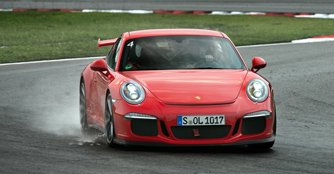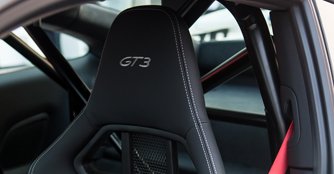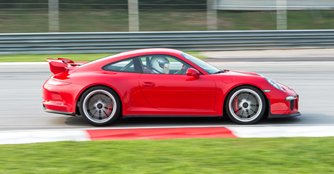Porsche 911 GT3 PDK 3.8 (A) First Drive Review
05 Dec 2014|10,441 views
In the modern era of cars where luxury and comfort are expected, hardcore, track-inspired models are having a hard time convincing buyers of their business case.
Also, this dying breed of cars is often misunderstood. Usually costing a premium over their bulked-up, better-equipped and more luxurious stablemates, the idea of 'paying more for less' can be hard to accept.
Hence, it takes more than a fast car nut (and a deep pocket one) to understand and appreciate the GT3. For starters, it isn't the fastest or the most powerful model in Porsche's arena, which means those after the mindless 'horsepower chase' need not apply.
But for keen drivers who have a soft spot for lightweight, rear-wheel drive sports car, the GT3's appeal is almost hard to negate.
Also, this dying breed of cars is often misunderstood. Usually costing a premium over their bulked-up, better-equipped and more luxurious stablemates, the idea of 'paying more for less' can be hard to accept.
Hence, it takes more than a fast car nut (and a deep pocket one) to understand and appreciate the GT3. For starters, it isn't the fastest or the most powerful model in Porsche's arena, which means those after the mindless 'horsepower chase' need not apply.
But for keen drivers who have a soft spot for lightweight, rear-wheel drive sports car, the GT3's appeal is almost hard to negate.
 |
Exterior
In this latest iteration, the GT3 is much more prominent than before. Like the generations before, the track machine has all the necessary bits to make it a proper sports car - only to a bigger extent this time as the car has grown in almost all areas. Other than the enlarged air inlet and front splitter, the fixed rear wing, which is unique to the GT3, is its best tell tale sign.
Put next to the 911 Turbo, the GT3 still carries an unmistakable aura, one that is less flashy, more built-for-purpose and speaks of its track-oriented capabilities.
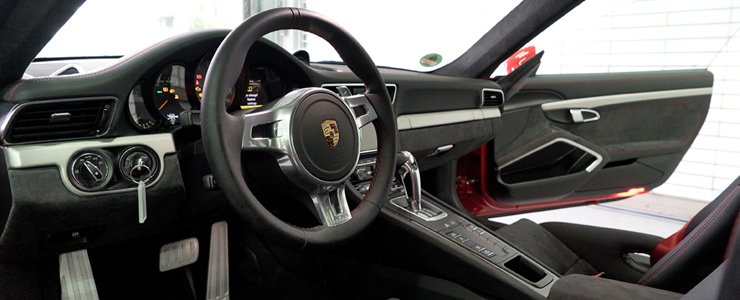 |
Interior
Expectedly, the GT3's interior feels more 'pared to the bone' than the usual 911. A roll cage now takes the place of the rear seats, giving an immediate sense of purposefulness.
Alcantara, a material that is commonly found on lightweight sports cars, has also replaced leather in numerous areas, such as the lower part of the dashboard and door cards.
Compared to other sports cars we've been into, the GT3's cabin is one of the least flashy, with most decorations coloured in a dark-ish grey hue (with exception of the red seat belts). That said, it still carries a unique sense of purposefulness to it.
Likewise, the steering wheel is totally void of any buttons or controls. That is, perhaps, its way of giving a subtle hint that the car requires every attention from the driver.
Expectedly, the GT3's interior feels more 'pared to the bone' than the usual 911. A roll cage now takes the place of the rear seats, giving an immediate sense of purposefulness.
Alcantara, a material that is commonly found on lightweight sports cars, has also replaced leather in numerous areas, such as the lower part of the dashboard and door cards.
Compared to other sports cars we've been into, the GT3's cabin is one of the least flashy, with most decorations coloured in a dark-ish grey hue (with exception of the red seat belts). That said, it still carries a unique sense of purposefulness to it.
Likewise, the steering wheel is totally void of any buttons or controls. That is, perhaps, its way of giving a subtle hint that the car requires every attention from the driver.
The Drive
Aside from the grown dimensions, the biggest change in the GT3 lies in its engine. Ditching the renowned 'Mezger' unit (named after Hans Mezger, the engineer who designed the powerplant), the GT3's 3.8-litre block has been completely redeveloped. Power is now rated at 475bhp, up from 435bhp in the predecessor.
More than the eye-watering figures, one characteristic that defines the new GT3 is its intoxicating 9,000rpm redline. At full chat, the flat-six unit emits a soul-awakening roar that makes the car feel as though it has come alive.
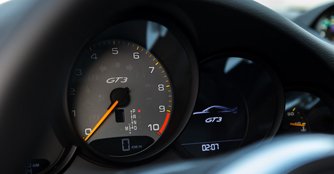
 The 3.8-litre flat-six stings with almost instantaneous
The 3.8-litre flat-six stings with almost instantaneous
response to the throttle, and will sing all the way to 9,000rpm
In fact, the GT3's engine feels more like a living thing than a machine, with a lively character that is easily evoked via its light and sensitive throttle.
Aside from the grown dimensions, the biggest change in the GT3 lies in its engine. Ditching the renowned 'Mezger' unit (named after Hans Mezger, the engineer who designed the powerplant), the GT3's 3.8-litre block has been completely redeveloped. Power is now rated at 475bhp, up from 435bhp in the predecessor.
More than the eye-watering figures, one characteristic that defines the new GT3 is its intoxicating 9,000rpm redline. At full chat, the flat-six unit emits a soul-awakening roar that makes the car feel as though it has come alive.

response to the throttle, and will sing all the way to 9,000rpm
In fact, the GT3's engine feels more like a living thing than a machine, with a lively character that is easily evoked via its light and sensitive throttle.
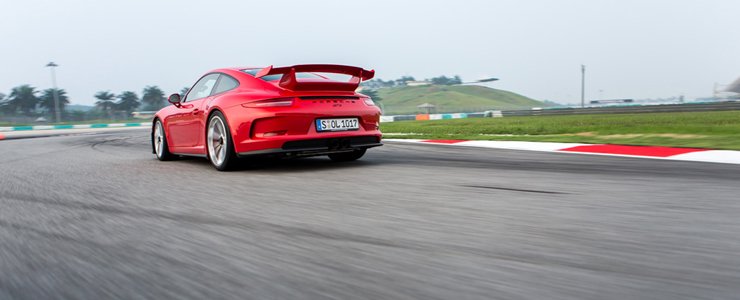 |
That, perhaps, has got to do with how the car behaves on the race track. At any given corner, the GT3's trait as a rear-wheel drive car is clearly demonstrated by how 'tail-happy' it is.
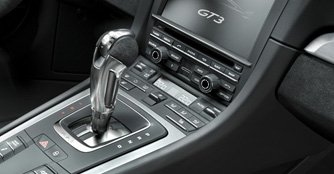
 The conventional stick shift may be gone, but the dual-clutch PDK gearbox, with its lightning-quick shifts, makes the GT3's performance much more attainable for the layman
The conventional stick shift may be gone, but the dual-clutch PDK gearbox, with its lightning-quick shifts, makes the GT3's performance much more attainable for the layman
Even when wrapped in sticky rubber, the GT3's ballistic power gives it the ability to light its rear tyres at will and lose traction. As such, you'll need to always be 'on the ball' and stay mindful of every steering, throttle and brake input.
Thankfully, the precise and well-weighted steering helps a great deal in pointing the car in the right direction.

Even when wrapped in sticky rubber, the GT3's ballistic power gives it the ability to light its rear tyres at will and lose traction. As such, you'll need to always be 'on the ball' and stay mindful of every steering, throttle and brake input.
Thankfully, the precise and well-weighted steering helps a great deal in pointing the car in the right direction.
There are also effective brakes to help to rein in the beast before every turn. While the carbon ceramic brakes (PCCB) are said to be more resistant to brake fading, and hence more suitable for those with track ambition, the 'normal' ones on the test car are no less efficient in shredding speed.
Conclusion
The latest GT3, with its pinpoint accuracy and startling pace, is no doubt a track-oriented sports car for the keen driver. While it may not sit at the top of the 911 family tree, going for one certainly isn't settling for second best.
And that only brings us to one question: How much more potent can the more lightweight and hardcore GT3 RS be?
Conclusion
The latest GT3, with its pinpoint accuracy and startling pace, is no doubt a track-oriented sports car for the keen driver. While it may not sit at the top of the 911 family tree, going for one certainly isn't settling for second best.
And that only brings us to one question: How much more potent can the more lightweight and hardcore GT3 RS be?
In the modern era of cars where luxury and comfort are expected, hardcore, track-inspired models are having a hard time convincing buyers of their business case.
Also, this dying breed of cars is often misunderstood. Usually costing a premium over their bulked-up, better-equipped and more luxurious stablemates, the idea of 'paying more for less' can be hard to accept.
Hence, it takes more than a fast car nut (and a deep pocket one) to understand and appreciate the GT3. For starters, it isn't the fastest or the most powerful model in Porsche's arena, which means those after the mindless 'horsepower chase' need not apply.
But for keen drivers who have a soft spot for lightweight, rear-wheel drive sports car, the GT3's appeal is almost hard to negate.
Also, this dying breed of cars is often misunderstood. Usually costing a premium over their bulked-up, better-equipped and more luxurious stablemates, the idea of 'paying more for less' can be hard to accept.
Hence, it takes more than a fast car nut (and a deep pocket one) to understand and appreciate the GT3. For starters, it isn't the fastest or the most powerful model in Porsche's arena, which means those after the mindless 'horsepower chase' need not apply.
But for keen drivers who have a soft spot for lightweight, rear-wheel drive sports car, the GT3's appeal is almost hard to negate.
Exterior
In this latest iteration, the GT3 is much more prominent than before. Like the generations before, the track machine has all the necessary bits to make it a proper sports car - only to a bigger extent this time as the car has grown in almost all areas. Other than the enlarged air inlet and front splitter, the fixed rear wing, which is unique to the GT3, is its best tell tale sign.
Put next to the 911 Turbo, the GT3 still carries an unmistakable aura, one that is less flashy, more built-for-purpose and speaks of its track-oriented capabilities.
Interior
Expectedly, the GT3's interior feels more 'pared to the bone' than the usual 911. A roll cage now takes the place of the rear seats, giving an immediate sense of purposefulness.
Alcantara, a material that is commonly found on lightweight sports cars, has also replaced leather in numerous areas, such as the lower part of the dashboard and door cards.
Compared to other sports cars we've been into, the GT3's cabin is one of the least flashy, with most decorations coloured in a dark-ish grey hue (with exception of the red seat belts). That said, it still carries a unique sense of purposefulness to it.
Likewise, the steering wheel is totally void of any buttons or controls. That is, perhaps, its way of giving a subtle hint that the car requires every attention from the driver.
Expectedly, the GT3's interior feels more 'pared to the bone' than the usual 911. A roll cage now takes the place of the rear seats, giving an immediate sense of purposefulness.
Alcantara, a material that is commonly found on lightweight sports cars, has also replaced leather in numerous areas, such as the lower part of the dashboard and door cards.
Compared to other sports cars we've been into, the GT3's cabin is one of the least flashy, with most decorations coloured in a dark-ish grey hue (with exception of the red seat belts). That said, it still carries a unique sense of purposefulness to it.
Likewise, the steering wheel is totally void of any buttons or controls. That is, perhaps, its way of giving a subtle hint that the car requires every attention from the driver.
The Drive
Aside from the grown dimensions, the biggest change in the GT3 lies in its engine. Ditching the renowned 'Mezger' unit (named after Hans Mezger, the engineer who designed the powerplant), the GT3's 3.8-litre block has been completely redeveloped. Power is now rated at 475bhp, up from 435bhp in the predecessor.
More than the eye-watering figures, one characteristic that defines the new GT3 is its intoxicating 9,000rpm redline. At full chat, the flat-six unit emits a soul-awakening roar that makes the car feel as though it has come alive.
In fact, the GT3's engine feels more like a living thing than a machine, with a lively character that is easily evoked via its light and sensitive throttle.
That, perhaps, has got to do with how the car behaves on the race track. At any given corner, the GT3's trait as a rear-wheel drive car is clearly demonstrated by how 'tail-happy' it is.
Even when wrapped in sticky rubber, the GT3's ballistic power gives it the ability to light its rear tyres at will and lose traction. As such, you'll need to always be 'on the ball' and stay mindful of every steering, throttle and brake input.
Thankfully, the precise and well-weighted steering helps a great deal in pointing the car in the right direction.
Even when wrapped in sticky rubber, the GT3's ballistic power gives it the ability to light its rear tyres at will and lose traction. As such, you'll need to always be 'on the ball' and stay mindful of every steering, throttle and brake input.
Thankfully, the precise and well-weighted steering helps a great deal in pointing the car in the right direction.
There are also effective brakes to help to rein in the beast before every turn. While the carbon ceramic brakes (PCCB) are said to be more resistant to brake fading, and hence more suitable for those with track ambition, the 'normal' ones on the test car are no less efficient in shredding speed.
Conclusion
The latest GT3, with its pinpoint accuracy and startling pace, is no doubt a track-oriented sports car for the keen driver. While it may not sit at the top of the 911 family tree, going for one certainly isn't settling for second best.
And that only brings us to one question: How much more potent can the more lightweight and hardcore GT3 RS be?
Conclusion
The latest GT3, with its pinpoint accuracy and startling pace, is no doubt a track-oriented sports car for the keen driver. While it may not sit at the top of the 911 family tree, going for one certainly isn't settling for second best.
And that only brings us to one question: How much more potent can the more lightweight and hardcore GT3 RS be?
Car Information
Porsche 911 Carrera GT3 (A)
CAT B|Petrol|8.06km/L
Horsepower
354kW (475 bhp)
Torque
440 Nm
Acceleration
3.5sec (0-100km /hr)
This model is no longer being sold by local distributor
All Used Porsche 911 CarreraThank You For Your Subscription.















